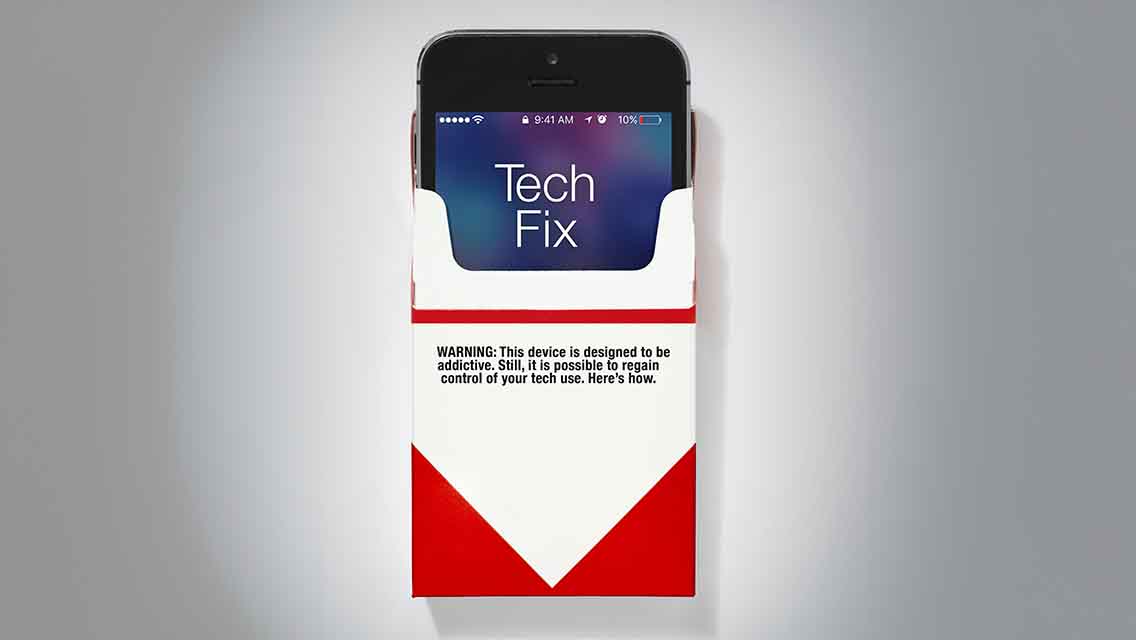In the 1950s and ’60s, smoking was ubiquitous in American culture — cigarettes in offices, cigarettes in restaurants, cigarettes on airplanes, and even in hospitals. Yet when we look back at images from that era, we’re shocked that something so obviously toxic was not just widely accepted but actively promoted as the pinnacle of sophistication, not to mention a handy tool for weight management. What were we thinking?
Now take a look around. Where is your smartphone? If you’re a typical American, it’s within 5 feet of you, regardless of the time of day. It may be in your hand while you read these words on its bright face.
Seventy-seven percent of Americans now own a smartphone. (Ninety-five percent own a cell phone of some kind.) The same people who eschew cigarettes because of their health risks might not think twice about driving down a highway at 60 miles per hour with their eyes locked on a tiny screen. We sleep with our phones beside us. They’re often the last thing we see before closing our eyes and the first thing we reach for in the morning.
The average American adult spends more than three hours engaging with his or her smartphone every day.
“The iPhone is only 10 years old,” says Larry Rosen, PhD, author of iDisorder and coauthor of The Distracted Mind. “In that time, we’ve gone from excitement to obsession.”
This obsession comes with significant costs to our health, relationships, cognition, and mood — and at the expense of fully experiencing our lives.
Will we look back someday at our screen infatuation with disbelief, as we do now with smoking, and shake our heads at historical images of restaurant tables full of people staring at the devices in their hands? Or will our captivation with ever-more sophisticated devices continue to blind us to the fact that they aren’t really connecting us to anything but the screens themselves?
Even though our phones are cleverly designed to capture our attention, we can choose how much of our time we give them.
Addictive by Design
Most of us have unthinkingly reached for the phone at a stoplight, or found our thumbs, seemingly of their own will, refreshing email or scrolling through a social-media feed. We’ve peeked at text messages while someone was speaking to us, or felt antsy in a work meeting that kept us from checking email.
Almost anyone with a smartphone suffers from some degree of technology addiction. As with cigarettes, this is by design. It’s not that we simply lack self-control; our devices, gadgets, apps, and games are made to be addictive.
Addiction is tied to the release of dopamine in the brain, explains Nicholas Kardaras, PhD, author of Glow Kids: How Screen Addiction Is Hijacking Our Kids — and How to Break the Trance. The more dopamine an activity or substance triggers, the more addictive it is.
“Our devices are designed to be dopaminergic,” says Kardaras, citing a study showing that old-school, nonimmersive video games raise dopamine levels as high as sex does. “We’re exposing people to the intensity of what’s basically a digital orgasm. But unlike orgasms from sex, digital orgasms happen continually.”
We’re also wired to seek novelty, and the Internet offers an infinite supply. Peter Whybrow, MD, director of the Semel Institute for Neuroscience and Human Behavior at the University of California, Los Angeles, describes computers as “electronic cocaine.” When seemingly everything is always available online, natural obstacles (such as darkness and distance) that once interrupted reward-seeking behaviors no longer apply, he notes.
Even Tony Fadell, who helped develop the iPhone, believes we need to address our tech addiction. “Would you give your kid cigarettes?” he asked the audience at last fall’s Mindfulness in America conference. “Would you keep a bottle of alcohol next to your bed?” Likewise, he suggested, we need to treat our phones as if they were one of these substances.
These are four things tech exploits to play to our addictive tendencies:
1. Randomized Rewards
Our apps and devices operate on the same principle as slot machines, delivering rewards on a random schedule. They keep us hoping, for instance, that the next scan of the email inbox or Facebook feed could reveal an interesting message or headline — a digital jackpot. It rarely occurs, but we’re hooked, mollified by smaller rewards: a validating tweet or a Facebook like.
2. Endless Sources of Information
A recent study found that people who ate soup from self-filling, “bottomless” bowls consumed 73 percent more than those eating from normal-size containers. They didn’t report greater satisfaction, however, and they substantially underestimated how much they’d eaten. It’s the picture of mindless consumption — eating because the food is there, not because it fulfills a need or delivers any pleasure.
Most of us require some kind of cue to stop consuming, but our devices provide no such thing. Scrolling has no breaks. Instagram and other apps might show only one like at a time, which keeps us checking back. Snapchat capitalizes on users’ loyalty to their friends by turning their conversations into streaks they don’t want to break, guaranteeing traffic.
Facebook uses an ever-evolving algorithm that tracks every like, comment, and click so it can predict what kinds of posts are most likely to keep users reading and feeds them accordingly. (Even some former Facebook employees who helped develop the like button acknowledge its power to override self-control, and they’ve begun to impose limits on their own engagement with it.)
3. Validation and Approval
A 2014 New York Times story reported that Facebook users were spending 39,757 collective years on the platform each day. When we’re there, we spend a lot of time liking things: photos, articles, status updates, recipes, videos, brands.
But we don’t seem to actually like spending our time this way.
Addiction research reveals that wanting something does not necessarily mean enjoying it. In his book Irresistible: The Rise of Addictive Technology and the Business of Keeping Us Hooked, New York University marketing professor Adam Alter, PhD, describes a study of drug addiction, performed by neuroscientist Kent Berridge, PhD:
“Addicts weren’t people who happened to like the drugs they were taking,” writes Alter. “They were people who wanted those drugs very badly even as they grew to dislike them. . . . What makes addiction so difficult to treat is that wanting is much harder to defeat than liking.”
Studies have found that Facebook, Instagram, and Snapchat rank high among apps that leave people feeling unhappy after use. And it seems the longer we engage with these apps, the worse we feel. This can be a difficult concept to grasp. How can we continue to want something we don’t like and continue to engage in destructive behavior that’s not even pleasurable?
Psychotherapist Nancy Colier, LCSW, author of The Power of Off: The Mindful Way to Stay Sane in a Virtual World, maintains that we keep hoping the next pull of the lever will hit the jackpot, yet it’s unlikely we’ll find that satisfaction we’re seeking online. “Looking for happiness on our devices,” she says, “is like trying to open a lock with a banana.”
“What we need to create well-being and a life well lived cannot be satisfied through technology,” she explains. “We’re feeding our inner reptile. The part of us that loves to anesthetize — that’s what technology feeds so well. Not the more evolved parts of ourselves.”
4. A Sense of Connection
We all want to belong somewhere, to find community, to share and connect. This connection is what technology promises.
“As human beings, we have this primal fear of isolation and not being part of the group, which is tantamount to extinction,” says Colier. “Technology is craftily being marketed to elicit this fear of Oh my god, if I don’t have this app or device, I won’t be part of the group.”
With most addictions, compulsive use has steep consequences: You may lose your job, your relationships, and your place in your community. But when tech is the drug, the opposite is true. Compulsive use can make you feel like an insider, and you may fear that your status, relationships, and career will suffer if you moderate your social-media presence or delay your response to every text, message, and email.
“Many of us have grown afraid that if we don’t continually tell the world who we are, as everyone else is doing, we will become invisible and irrelevant,” says Colier.
“If this happens, our very sense of self is called into question. Our life has become something we use to advertise our identity.”
Control Your Tech (So It Doesn’t Control You)
Technology addiction presents a unique challenge, because abstinence isn’t really an option for most of us.
“From a treatment perspective, we approach technology addiction like an eating disorder,” says Kardaras. “You can live a happy life abstinent from drugs and alcohol, but you can’t do that with food, and it’s probably unrealistic to think that we can be abstinent from technology.”
The key, he says, is to develop a healthy self-concept and a healthier, more balanced, conscious relationship with your devices. This means setting consistent boundaries and sticking with them.
For his intensely tech-addicted teenage clients, Kardaras recommends regular sessions in a sensory deprivation tank and extended periods in nature without access to screens; these help counteract the teens’ state of hyperactivation and reset an overstimulated adrenal system. For the rest of us, a range of techniques (both technological and analog) can help us regain a sense of control over our tech use. Start with these:
1) Do an appraisal. Fight fire with fire by downloading an app, such as Moment, that measures your tech use. It tracks how much time you spend looking at your screen and which apps you use most. Once you’ve acknowledged the reality of your current use (always the first step), you can set a goal for cutting back. The app can help with that as well.
2) Institute tech breaks. Rosen suggests deliberately scheduling time for tech use. “Imagine you’re a student studying,” he says, and try this:
- Allow yourself one minute to look at anything on your phone or computer. Then close (not just minimize) any programs or apps not required for your primary task. Silence your phone and set an alarm for 15 minutes.
- When the alarm goes off, look at anything you want for one minute, then repeat the cycle.
- As you become more focused, increase the tech-free time to 20 or 30 minutes, or longer. (SelfControl and other apps that allow you to block tempting websites for a predetermined length of time can add an extra layer of defense.)
3) Establish tech-free zones and times. “Mindful screen usage is when you’re not just reflexively reaching for your phone,” says Kardaras. “You can encourage that by creating screen-free time in your day.”
Consider these strategies:
- Institute a no-tech policy during meal times.
- Set aside blocks of time when you don’t use technology, such as the two hours before bed.
- Designate specific areas, such as the kitchen table and the couch where you wind down with your spouse in the evening, as device-free zones.
- Practice a “tech Sabbath” — a day without devices — once a week.
4) Take a broader view. When you understand how your brain works, you become more aware of your impulses and more able to consciously control your behavior. This kind of self-awareness is key to kicking addictions.
So the next time you reach for your phone to record a concert or snap a pic of your lunch, see if you can step back. Ask yourself if having that photo or video will really be valuable to you later. Observe whether it’s detracting from your ability to be present and to fully savor your life as it’s happening.
“You see movement and your brain says, ‘Record it!’” explains Rosen. “You think you’ll have it for posterity. But you’re not experiencing your life when you’re experiencing it through a lens.”
“Awareness is our refuge,” adds Colier. “Rather than immediately indulging, we can pause and say, ‘What would I have to feel right now if I didn’t use my phone?’”
She urges her clients struggling with an unhealthy relationship with their devices to contemplate larger questions, like What do I really want in my life? If human interactions are important to me, I can make choices that reflect and support that, such as keeping my phone out of sight when I’m with people I care about.
“A lot of it comes back to very small habits,” Colier says. “Where am I putting my attention and energy? Those are the building blocks of our lives.”
The Health Risks of Tech Addiction
Our smartphone obsession may seem to be relatively benign, especially when compared with habits such as smoking. But its effect on our well-being is not insignificant.
Nervous Systems on Overdrive
“We all look like we have obsessive-compulsive disorder,” says Larry Rosen, PhD, author of The Distracted Mind. “The average person checks his or her phone every 15 minutes or less, even with no notification.”
This affects our health. “When we’re in this constant state of anxiety, our systems are flooded with fight-or-flight chemicals,” explains psychotherapist Nancy Colier, LCSW. This ceaseless cycle of cortisol and dopamine can make us “twired” — simultaneously hyperstimulated and exhausted.
Disrupted Sleep
Hyperstimulation is just one effect of smartphones that harms our sleep quality. Many of us go to bed with our phones beside us, making it easy to succumb to the blue glow of the screen until we close our eyes. This blue light disrupts our circadian rhythms, tricking our bodies into thinking it’s daytime, which leads to sleep disturbances. Add the temptation to check your phone during the night and you have the ingredients for a poor night’s rest.
As Colier points out, “we power down our devices so they can reboot, but we need to do the same for ourselves.” (For more on circadian health, go to “Get in Sync.”)
Scattered Attention
In 2000 the average person’s attention span was 12 seconds. By 2015 it had dropped to eight seconds. (A goldfish has an attention span of nine seconds.) As we continue to distract ourselves in the quest for novelty and stimulation, we may be hindering the next generation’s cognitive abilities as well. One recent study found infants’ attention spans suffer when their caregivers’ eyes wander to smartphones and other technological distractions during playtime, which may impair their capacity for language acquisition and problem-solving.
Faulty Connections With Others
An ad for the latest version of the Apple Watch proudly declares that you can now “stay connected, even when you’re away from your phone.” Even our mobile phones are no longer mobile enough. We fear being disconnected, even for a moment. But the very benefit this technology promises — connection — suffers most from our addiction.
One famous study showed that the mere presence of a cell phone diminished the quality of conversation and subjective experience of trust, empathy, and closeness between two people discussing a meaningful topic.
“We’re social animals,” says Nicholas Kardaras, PhD, “and we think technology is a panacea that’s going to keep us connected, but depression rates are skyrocketing. We’ve been sold this false narrative that it’s connecting us. We’ve been lulled by how amazing these devices are, but we didn’t fully vet the dark side.”





This Post Has 0 Comments